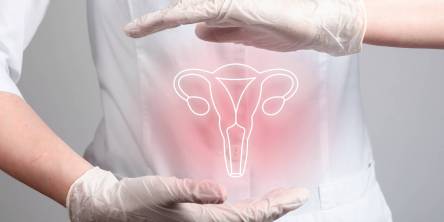Are Uterine Fibroids Dangerous for Pregnancy?
Uterine fibroids are benign tumors that develop in the uterine muscle tissue. According to the US Office on Women's Health (OWH), fibroids can grow as a single tumor or as a cluster in the uterus, and they can be as small as an apple seed or as large as a grapefruit. A fibroid may remain small for a long time before suddenly growing, or it may grow slowly over time. They can cause abdominal pain and other symptoms, but a woman may be unaware she has uterine fibroids until they are discovered during a pelvic check or pregnancy ultrasound.
Uterine fibroids are classified into several types:
- Intramural fibroids are fibroids that grow within the uterine walls but remain outside of the uterine cavity;
- Submucosal fibroids are fibroids that push into the uterine cavity;
- Subserosal fibroids are fibroids that grow on the exterior of the uterus.
A malignant fibroid called a leiomyosarcoma can occur in very rare situations, but according to the OWH, they do not originate from an existing fibroid. Having uterine fibroids does not raise your chances of acquiring a malignant fibroid or having uterine cancer.
What Are the Causes of Uterine Fibroids?
It's not entirely understood what causes uterine fibroids to form, but according to the OWH, hormones, specifically estrogen and progesterone levels and genes may play a role. According to the OWH, up to 80% of women get fibroids by the age of 50, with women in their 40s and early 50s being the most prevalent.
Do Uterine Fibroids Have an Impact on Pregnancy?
According to the OWH, most women with uterine fibroids have normal pregnancies, while the presence of these growths increases your risk of difficulties during pregnancy and delivery. Fibroids have been connected to miscarriage and preterm birth in the past, but there are so many other factors that play into these outcomes that it's difficult to determine for certain if fibroids are a cause. It is worth noting: The American Journal of Epidemiology conducted a study in 2017 that revealed no association between uterine fibroids and miscarriage.
Fibroids can cause infertility in rare situations, however, the American College of Obstetricians and Gynecologists (ACOG) says women can commonly become pregnant after fibroids treatment. If you have a history of fibroids, speak with your doctor about having any fibroids in your uterine cavity removed before trying to conceive.
Uterine fibroids tend to breed anxiety among patients when the truth of the matter is that they aren't usually going to have any problems in pregnancy. Sometimes patients don't even know they have them and see them first on ultrasound.
Uterine Fibroid Symptoms During Pregnancy
Uterine fibroids can be "masked" during pregnancy, which means that the symptoms of uterine fibroids might be readily confused with common pregnancy symptoms. Uterine fibroids during pregnancy can cause the following symptoms:
- Pelvic discomfort or pressure;
- Back pain in the lower back;
- Spotting or bleeding during sex;
- Urination on a regular basis;
- Constipation;
- Heaviness or swelling in the abdomen.
Some women with fibroids, however, experience no symptoms at all.
How to Identify Uterine Fibroids
When you are not pregnant, there are numerous tests that can be used to diagnose uterine fibroids. They are frequently found on ultrasound during pregnancy.
Uterine Fibroid Treatment During Pregnancy
Your prenatal treatment will not be altered simply because you have uterine fibroids. Rather, your doctor will monitor your fibroids while the baby grows.
How to Manage Uterine Fibroids Pain Safely
During pregnancy, uterine fibroids can cause pain. While it is usually short-lived, it can cause pretty significant pain for a week to 10 days. As the baby grows, blood flow can be transferred from the fibroids to the developing fetus, causing the tumors to die off.
Speak with your doctor if you are experiencing pain from fibroids during your pregnancy. They may recommend anti-inflammatory drugs or potentially greater pain medication as uterine fibroid treatment.
Similar Articles
Your pregnancy test came back positive, and nothing, not even early pregnancy symptoms like morning sickness or exhaustion, can dampen your spirits. However, it is natural to worry about what to do when you discover you are pregnant.
A breast lift, like any other operation, involves skin incisions. Scarring occurs when your skin generates new tissues and mends the wound after an incision. There are, however, measures to reduce scarring before, during, and after a breast lift.
The cervix's proper functioning is crucial to a woman's reproductive health and fertility. However, most women do not know anything or have a limited understanding of it. As a result, there are numerous misconceptions surrounding cervical health.
Do many nighttime wake-up calls or interruptions to your daytime activities result from frequent bathroom visits? Six to seven trips to the bathroom in a 24-hour period is normal for most people. However, urinating more frequently could be a symptom of a serious problem.
The cervix is the lower part of the womb (uterus), where the fetus develops during pregnancy. A tiny hole in the cervix widens during birthing. It also lets menstrual blood exit her body.
Shatavari is a very renowned ayurvedic herb containing plenty of health benefits. It is also known as the universal rasayan. The word shatavari refers to a woman with a hundred husbands signifying the traditional use of this herb to boost the reproductive system of the body.
Despite the fact that around half of the world's population experiences, will experience, or has experienced menstruation, misunderstandings regarding this biological process remain.
Throughout your life, you may anticipate getting your period roughly 450 times. Even if you've gotten the hang of your cycle, there's a good possibility that some menstruation mysteries remain unanswered
Annual gynecological check-ups are essential for every woman to stay healthy. However, there are a lot of conditions that require medical attention. You should understand that the sooner you will be diagnosed and treated, the easier and more effective the treatment will be









